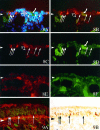Analysis of the globose basal cell compartment in rat olfactory epithelium using GBC-1, a new monoclonal antibody against globose basal cells
- PMID: 8656294
- PMCID: PMC6578610
- DOI: 10.1523/JNEUROSCI.16-12-04005.1996
Analysis of the globose basal cell compartment in rat olfactory epithelium using GBC-1, a new monoclonal antibody against globose basal cells
Abstract
The olfactory epithelium (OE) supports ongoing neurogenesis throughout life and regenerates after experimental injury. Although evidence indicates that proliferative cells within the population of globose (light) basal cells (GBCs) give rise to new neurons, little is known about the biology of GBCs. Because GBCs have been identifiable only by an absence of staining with reagents that mark other cell types in the epithelium, we undertook to isolate antibodies that specifically react against GBCs and to characterize the GBC compartment in normal and regenerating OE. Monoclonal antibodies were produced using mice immunized with regenerating rat OE, and a monoclonal antibody designated GBC-1, which reacts against GBCs of the rat OE, was isolated. In immunohistochemical analyses, antibody GBC-1 was found to label GBCs in both normal and regenerating OE as we are currently able to define them: basal cells that incorporate the mitotic tracer bromodeoxyuridine and fail to express cytokeratins or neural cell adhesion molecule. During epithelial reconstitution after direct experimental injury with methyl bromide, expression of the GBC-1 antigen overlaps to a limited extent with expression of cell-specific markers for horizontal basal cells, Bowman's gland and sustentacular cells, and neurons. These data suggest that GBC-1 may mark multipotent cells residing in the GBC compartment, which are prominent during regeneration. However, a limited number of cells in the regenerating OE with other phenotypic characteristics of GBCs lack expression of the GBC-1 antigen. GBC-1 has revealed novel aspects of GBC biology and will be useful for studying the process of olfactory neurogenesis.
Figures






Similar articles
-
Globose basal cells are required for reconstitution of olfactory epithelium after methyl bromide lesion.J Comp Neurol. 2003 May 19;460(1):123-40. doi: 10.1002/cne.10642. J Comp Neurol. 2003. PMID: 12687701 Free PMC article.
-
Nonintegrin laminin receptor precursor protein is expressed on olfactory stem and progenitor cells.J Comp Neurol. 2007 May 20;502(3):367-81. doi: 10.1002/cne.21328. J Comp Neurol. 2007. PMID: 17366606 Free PMC article.
-
Multipotency of purified, transplanted globose basal cells in olfactory epithelium.J Comp Neurol. 2004 Feb 16;469(4):457-74. doi: 10.1002/cne.11031. J Comp Neurol. 2004. PMID: 14755529
-
Stem and progenitor cells of the mammalian olfactory epithelium: Taking poietic license.J Comp Neurol. 2017 Mar 1;525(4):1034-1054. doi: 10.1002/cne.24105. Epub 2016 Sep 27. J Comp Neurol. 2017. PMID: 27560601 Free PMC article. Review.
-
Identification and molecular regulation of neural stem cells in the olfactory epithelium.Exp Cell Res. 2005 Jun 10;306(2):309-16. doi: 10.1016/j.yexcr.2005.03.027. Epub 2005 Apr 21. Exp Cell Res. 2005. PMID: 15925585 Review.
Cited by
-
Pathophysiology of Olfactory Disorders and Potential Treatment Strategies.Curr Otorhinolaryngol Rep. 2016 Jun;4(2):115-121. doi: 10.1007/s40136-016-0113-5. Curr Otorhinolaryngol Rep. 2016. PMID: 27529054 Free PMC article.
-
Acute N-Acetylcysteine Administration Ameliorates Loss of Olfactory Neurons Following Experimental Injury In Vivo.Anat Rec (Hoboken). 2020 Mar;303(3):626-633. doi: 10.1002/ar.24066. Epub 2019 Jan 25. Anat Rec (Hoboken). 2020. PMID: 30632702 Free PMC article.
-
Olfactory uptake of manganese requires DMT1 and is enhanced by anemia.FASEB J. 2007 Jan;21(1):223-30. doi: 10.1096/fj.06-6710com. Epub 2006 Nov 20. FASEB J. 2007. PMID: 17116743 Free PMC article.
-
Embryonic Pax7-expressing progenitors contribute multiple cell types to the postnatal olfactory epithelium.J Neurosci. 2010 Jul 14;30(28):9523-32. doi: 10.1523/JNEUROSCI.0867-10.2010. J Neurosci. 2010. PMID: 20631180 Free PMC article.
-
Neuropeptide Y and extracellular signal-regulated kinase mediate injury-induced neuroregeneration in mouse olfactory epithelium.Mol Cell Neurosci. 2012 Feb;49(2):158-70. doi: 10.1016/j.mcn.2011.11.004. Epub 2011 Nov 30. Mol Cell Neurosci. 2012. PMID: 22154958 Free PMC article.
References
-
- Akeson RA, Haines SL. Rat olfactory cells and a central nervous system neuronal subpopulation share a cell surface antigen. Brain Res. 1989;488:202–212. - PubMed
-
- Blaugrund E, Pham TD, Tennyson VM, Lo L, Sommer L, Anderson DJ, Gershon MD. Distinct subpopulations of enteric neuronal progenitors defined by time of development, sympathoadrenal lineage markers and Mash-1 dependence. Development. 1996;122:309–320. - PubMed
-
- Caggiano M, Kauer JS, Hunter DD. Globose basal cells are neuronal progenitors in the olfactory epithelium: a lineage analysis using a replication-incompetent retrovirus. Neuron. 1994;13:339–352. - PubMed
-
- Calof AL, Chikaraishi DM. Analysis of neurogenesis in a mammalian neuroepithelium: proliferation and differentiation of an olfactory neuron precursor in vitro . Neuron. 1989;3:115–127. - PubMed
Publication types
MeSH terms
Substances
Grants and funding
LinkOut - more resources
Full Text Sources
Other Literature Sources
